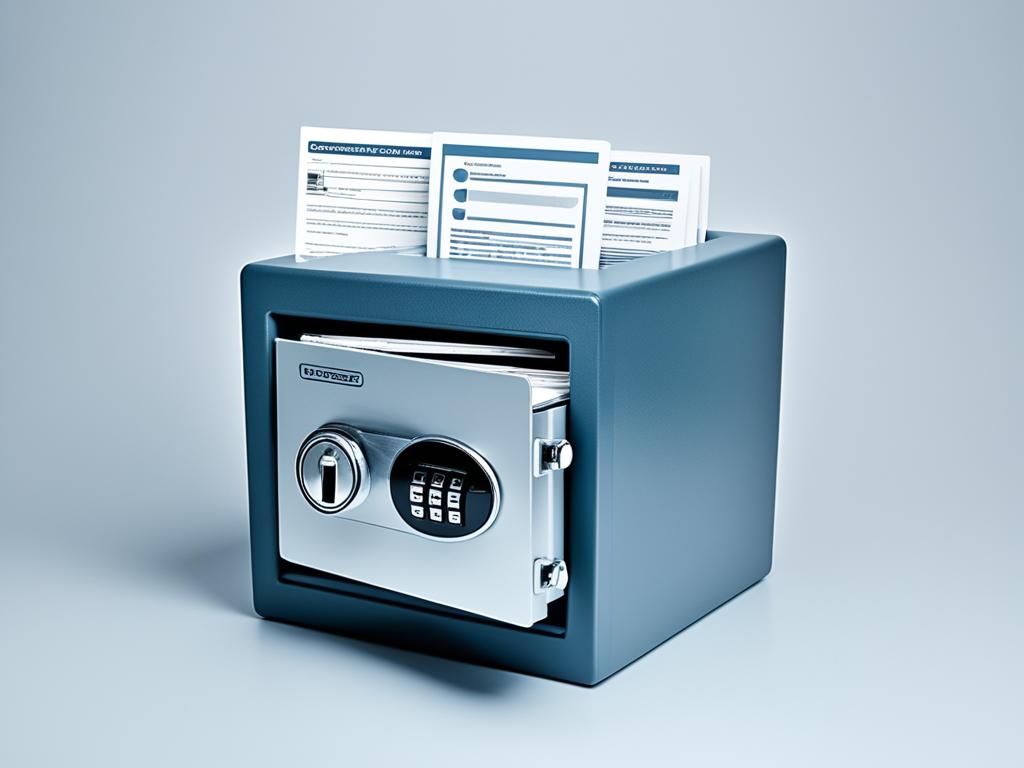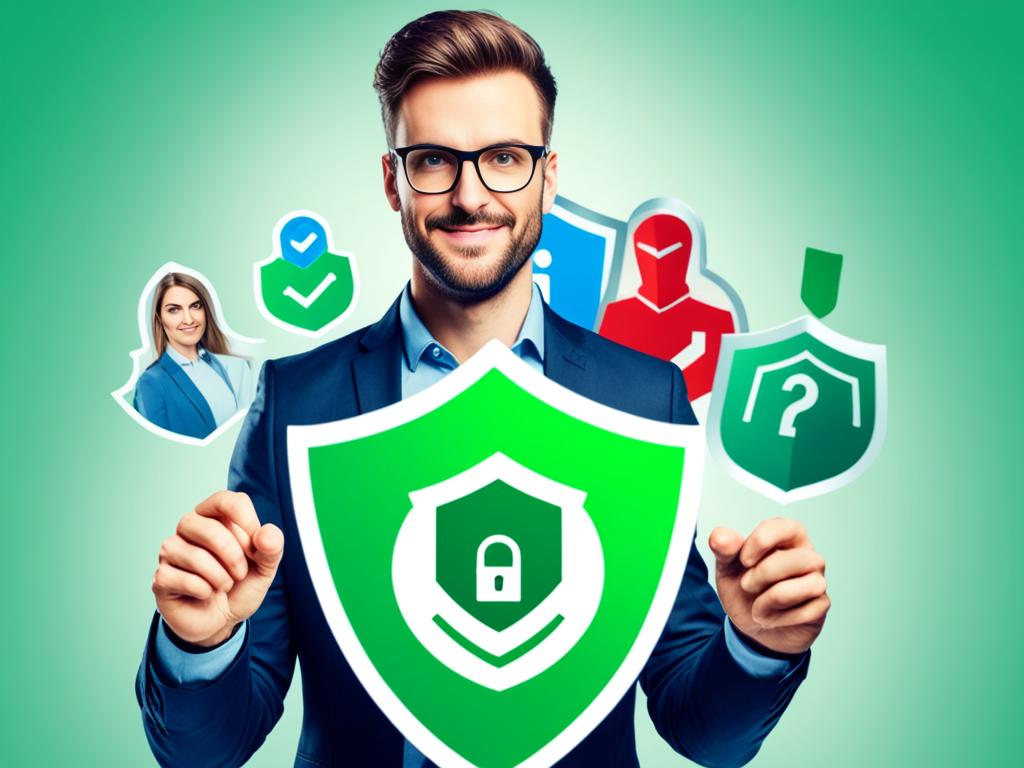October 2023 marks the 20th anniversary of Cybersecurity Awareness Month. This event shows how security awareness has grown in the United States. The University of California is focusing on “Protect Your Digital Life – Be CyberSafe” this October.
Phishing has been a threat since the early 1990s. It uses the internet to reach many people. The 2020 Colonial Pipeline attack showed how phishing has gotten more complex. The Anti-phishing Working Group says phishing attacks tripled by 2020, reaching a record high in December 2021.
Phishing Protection: Phishing Protection is the first line of defense against online threats. In today’s digital age, it’s crucial to safeguard your personal and financial information from falling into the wrong hands. Phishing protection measures prevent malicious actors from tricking you into revealing sensitive data or clicking on harmful links. With robust phishing protection in place, you can rest assured that your online transactions and communications are secure.
Email Security: Email Security is a top priority in today’s digital landscape. Hackers often exploit email vulnerabilities to spread malware, steal passwords, and compromise sensitive information. Email security measures, such as encryption, authentication, and filtering, prevent malicious emails from reaching your inbox. By securing your email communication, you can protect yourself against cyber threats and maintain the confidentiality of your online interactions.
Spear Phishing: Spear Phishing is a sophisticated form of phishing that targets specific individuals or organizations with tailored attacks. These attacks often appear legitimate, making it difficult to detect the malicious intent. Spear phishing attempts to trick victims into revealing sensitive information, such as passwords, credit card numbers, or confidential data. To stay ahead of these threats, you need to be aware of the tactics used in spear phishing and implement robust security measures to prevent successful attacks.
Anti-Phishing Tools: Anti-Phishing Tools are essential for detecting and preventing phishing attempts. These tools use advanced algorithms and machine learning techniques to analyze email patterns, URLs, and attachments, identifying potential threats before they reach your inbox. Anti-phishing tools can also provide real-time alerts and warnings, enabling you to take swift action against suspected attacks. By leveraging anti-phishing tools, you can significantly reduce the risk of falling victim to phishing scams and protect your digital assets from cybercriminals.
Key Takeaways
- Phishing has been a threat since the early days of the internet, evolving in sophistication over time.
- The scale of phishing attacks has grown exponentially, with a tripling of attempts since 2020.
- Educating end-users on identifying phishing scams is a crucial aspect of phishing prevention.
- A multi-layered defense strategy combining human vigilance and advanced software solutions is essential for comprehensive anti-phishing efforts.
- Fostering a culture of cybersecurity awareness and reporting within organizations is key to mitigating phishing risks.
The Importance of Cybersecurity Awareness
As we use more digital tools, keeping our data safe is key. Cyber threats like phishing, malware, and social engineering are real risks. Learning about cybersecurity helps protect our identity, money, and businesses.
Understanding Cybersecurity Threats
Cybercriminals are always finding new ways to get into our online lives. In 2022, cyber-attacks cost businesses about $4.35 million. By 2025, 45% of global companies might face supply chain attacks.
1 in 10 U.S. organizations don’t have cyber insurance. This shows how big the risks are.
Protecting Personal Information and Assets
Knowing about cybersecurity is key to keeping our info safe. Most data breaches come from stolen passwords. Human mistakes cause 74% of these breaches.
By learning about cybersecurity, we can avoid identity theft and financial losses. Training in cybersecurity helps prevent data breaches and keeps businesses ahead. Customers trust companies that take cybersecurity seriously.
| Cybersecurity Threat | Impact | Preventive Measures |
|---|---|---|
| Phishing Attacks | Identity theft, financial loss | Employee training, multi-factor authentication |
| Malware and Ransomware | Data loss, system disruption | Regular software updates, backup solutions |
| Social Engineering | Compromised sensitive information | Awareness training, scrutiny of requests |
| Password Attacks | Unauthorized access, data breaches | Strong password policies, password managers |
Recognizing Phishing Attacks
Phishing attacks are a common way scammers steal personal and financial info. They often look like emails, texts, or social media messages from trusted places like banks or government agencies. Their aim is to get victims to share sensitive info or click on harmful links.
Common Phishing Techniques
Scammers keep changing their ways to stay ahead. Here are some common tricks they use:
- They pretend to be from trusted companies or people.
- They send fake invoices or payment alerts.
- They link to websites with malware.
- They try to make you act fast without thinking.
Signs of a Phishing Scam
Here are signs to spot phishing scams:
- Look out for emails or messages with mistakes.
- Be wary of greetings like “Dear sir or madam”.
- Watch for sender addresses that don’t match the company name.
- Be cautious of requests for your personal or financial info.
- Don’t open links or attachments from unknown senders.
Stay alert and know the tricks phishers use to protect your email security from phishing identification scams. Always be careful with social engineering and any requests for your private info.
Phishing Prevention
Cybercriminals are getting better at trying to steal our personal info. They use phishing attacks to trick us into sharing sensitive data. To stay safe, we need to use strong anti-phishing strategies and follow cybersecurity best practices.
Phishing scams can look like fake emails, websites, or even calls and texts. They try to get us to share things like passwords or financial info. Knowing how to spot these scams helps us stay safe.
To fight phishing, we need to make cybersecurity a big part of our lives. This means:
- Using strong passwords and turning on two-factor authentication.
- Keeping our devices and software up to date with the latest security.
- Being careful with public Wi-Fi and thinking about using a VPN for important stuff.
- Backing up our data to protect it from hackers or ransomware.
Following these cybersecurity best practices lowers our chances of getting phished. It helps keep our online identities, money, and personal info safe.
Stopping phishing needs work from both people and companies. We must keep learning, stay alert, and use good security tools. This way, we can protect our online lives and keep our info safe.
Secure Password Practices
Keeping your digital identity safe is key. Use strong passwords to stop identity theft. Make your passwords hard to guess with a mix of letters, numbers, and symbols. Or, use a passphrase with 4-7 words. Always use unique passwords for each account to boost security.
For easy password handling, try a password manager. These tools make and keep your passwords safe on all devices. With a password manager, you can have strong, unique passwords for all accounts without remembering them.
Two-factor authentication (2FA) is another way to stop identity theft. It checks who you are with a second step, like a code on your phone or a scan. Adding 2FA to your accounts lowers the chance of someone else getting in, even if they have your password.
| Password Strength | Password Complexity | Password Manager | Two-Factor Authentication |
|---|---|---|---|
| At least 16 characters | Mix of letters, numbers, and symbols | Securely stores and manages passwords | Adds an extra layer of security |
| Unique for each account | Avoid common words or personal information | Generates strong, random passwords | Verifies your identity through a second step |
Follow these secure password practices to lower the chance of phishing attacks and unauthorized access. Remember, cybersecurity is always important. Stay alert to keep your digital life safe.
Keeping Software Updated
As someone who cares about digital security, I know how key it is to update my devices often. This keeps my devices safe and lowers the chance of cyber attacks.
Experts say updating software helps fix security issues. By keeping my software current, I shield myself from new threats. Sadly, about 73% of data breaches come from email scams, showing why keeping software updated is vital.
I set my devices to update automatically when I can. This keeps my system safe with the newest security. I also check for updates from my device makers and install any needed patches or fixes.
Putting software updates first helps me protect my online life. It’s a simple way to keep my digital world safe and secure.
| Cybersecurity Statistic | Percentage/Cost |
|---|---|
| Data breaches from email social engineering attacks | 73% |
| Average cost of a data breach | $3.92 million |
| Phishing attacks present in data breaches (2018) | 33% |
| Branded emails that are phishing emails | 1 in 25 |
| Organizations targeted by phishing attacks (2017) | 76% |
Secure Network Practices
When we’re online, we must watch out for security risks. Public Wi-Fi networks are a big worry. They can be a threat to our private info and online privacy.
Avoiding Public Wi-Fi for Sensitive Activities
Don’t use public Wi-Fi for important tasks like online banking or personal info. These networks can be hacked by bad guys. They could steal your data and use it for bad things. So, it’s smart to avoid public Wi-Fi for sensitive stuff.
Using Virtual Private Networks (VPNs)
A virtual private network (VPN) is a great way to stay safe online. It makes a secure tunnel to the internet. This way, your online actions are hidden from others. Using a VPN keeps your online privacy and security safe, even on public Wi-Fi.
Adding a VPN to your daily online life adds extra protection. It makes sure your public Wi-Fi and VPN use keep you safe online.
| Benefits of Using a VPN | Risks of Using Public Wi-Fi |
|---|---|
|
|
Data Backup and Recovery
With cyber threats growing, data backup and recovery are key to a strong cybersecurity plan. Backing up your files to an external drive or cloud keeps them safe from cyber attacks, system failures, or disasters. This way, you can lessen the damage from a security breach or losing data and recover quickly.
IBM says the average data breach costs $4.35 million, or about $164 per record. Cybercrime costs could hit $8 trillion in 2023 and maybe $10.5 trillion by 2025, says Cybersecurity Ventures. These numbers show how important it is to have good data backup and recovery plans.
To back up your data well, follow the 3-2-1 rule. Have three copies of your data on two different storage types, with one offsite. This keeps your data safe if a disaster or system failure happens. Also, update and automate your backups to keep your files current and reduce data loss.
| Backup Method | Storage Efficiency | Recovery Speed |
|---|---|---|
| Full Backup | High storage requirements | Fastest recovery time |
| Incremental Backup | Optimized storage usage | Longer recovery time |
| Differential Backup | Moderate storage usage | Quicker recovery than incremental |
| Mirror Backup | High storage requirements | Fastest recovery time |
Having a strong data backup and recovery plan protects your digital assets and keeps your business running. Always test and maintain your backup systems to make sure they work well when you need them for data backup or disaster recovery.

Social Engineering Awareness
Social engineering is a big threat in cybersecurity. It tricks people into sharing secret info by making them trust and help. Knowing how social engineering works helps us protect ourselves and our groups from these threats.
Many attacks use social engineering to get into a company. Big companies often get hacked because of it. That’s why learning about social engineering is key to keeping info safe.
Phishing is a common way to test how people react. It targets certain groups in a company. There’s also vishing and smishing, which use phone calls and texts to trick people. Watching how people act in these situations helps find weak spots and improve security.
Shockingly, 90% of workers might share their passwords for a small reward. In 2018, 30% of phishing emails got opened, and 12% clicked on dangerous links. This let hackers get into companies.
To fight social engineering, companies need strong security training. This teaches employees to spot and dodge these tricks. It also makes the whole company more careful about security.
Understanding social engineering and taking strong steps to protect ourselves is crucial. Staying alert and teaching our teams is how we keep safe from these threats.
Cybersecurity Training and Education
Keeping up with cybersecurity awareness, employee training, and security education is key today. It helps us all protect against cyber threats and keep our digital lives safe.
Small businesses face a big risk from phishing attacks because they often have less money for security. Hackers keep coming up with new ways to trick people. So, it’s important for employees to learn about these scams regularly.
Training employees to spot suspicious emails and actions is vital. It helps catch cyber threats early. Threat literacy training teaches how hackers use emails, websites, and social engineering to get into systems.
Using free training from IT companies or nonprofits can save money. It’s good to keep employees updated on the latest cybersecurity risks. This helps them stay alert and informed.
Creating a strong cybersecurity awareness in a company helps everyone stay safe online. It’s about teaching good online habits and encouraging people to report anything strange. Companies that teach their staff about phishing see a big drop in attacks.
Investing in good cybersecurity training and security education programs can really help protect against phishing. It makes a company stronger against online threats. Teaching employees to be watchful and ready to act is a great way to boost cybersecurity awareness.
Fostering a Cybersecurity Culture
Creating a strong cybersecurity culture is key to protecting against digital threats. It means having good security policies, encouraging people to report odd things, and giving employees the power to act. This makes a safe place that values keeping data safe and handling incidents well.
Organizational Policies and Procedures
Having clear security rules and steps is the base of a good cybersecurity culture. These rules tell what employees should do, how to handle incidents, and who is responsible. Keeping these rules up-to-date helps them stay useful against new threats.
Encouraging Reporting of Suspicious Activities
It’s important to have a place where people feel safe to share if they see something odd. Having easy ways to report things, promising privacy, and no revenge helps people to watch out for the company’s online safety.
| Strategies for Fostering Cybersecurity Culture | Key Benefits |
|---|---|
|
|
By building a cybersecurity culture, companies make their employees key players in protecting digital assets. This boosts the company’s strength and safety overall.

Conclusion
Cybersecurity awareness is key to keeping our digital lives safe. We need to know the threats, like phishing attacks, and how to fight them. This includes using strong passwords and keeping software updated.
It’s important to make cybersecurity a part of our work and personal lives. We should all report strange online activities. Getting good training and focusing on security helps everyone stay safe online.
Everyone has a role in cybersecurity, not just IT teams. By working together, we can protect our digital world from threats. Let’s all focus on online safety to keep ourselves and our loved ones safe.
Source Links
- https://vipre.com/glossary-terms/what-is-phishing/ – What is Phishing?: Risks and Prevention in the Digital Age – VIPRE
- https://perception-point.io/guides/phishing/how-to-prevent-phishing-attacks/ – What Is Anti-Phishing? Techniques to Prevent Phishing
- https://www.elev8me.com/insights/the-importance-of-cyber-security-awareness-training-for-employees – The Importance of Cyber Security Awareness Training
- https://www.cybsafe.com/blog/7-reasons-why-security-awareness-training-is-important/ – 7 reasons why security awareness training is important in 2023
- https://www.linkedin.com/pulse/critical-importance-cybersecurity-awareness-training-ibrahim-ucar-a7vif – The Critical Importance of Cybersecurity Awareness Training
- https://consumer.ftc.gov/articles/how-recognize-and-avoid-phishing-scams – How to Recognize and Avoid Phishing Scams
- https://support.microsoft.com/en-us/windows/protect-yourself-from-phishing-0c7ea947-ba98-3bd9-7184-430e1f860a44 – Protect yourself from phishing – Microsoft Support
- https://usa.kaspersky.com/resource-center/preemptive-safety/phishing-prevention-tips – Phishing Scams & Attacks – How to Protect Yourself
- https://www.lepide.com/blog/10-ways-to-prevent-phishing-attacks/ – 10 Ways to Prevent Phishing Attacks
- https://cofense.com/knowledge-center/anti-phishing-best-practices/ – Phishing Prevention: Email Security Best Practices
- https://www.cisa.gov/secure-our-world/use-strong-passwords – Use Strong Passwords | CISA
- https://www.cai.io/resources/articles/how-cybersecurity-practices-can-prevent-phishing – How to Prevent Phishing in Cybersecurity
- https://www.paylocity.com/resources/resource-library/blog-post/phishing-prevention/ – Top Phishing Prevention Tips
- https://www.phishprotection.com/content/phishing-prevention/phishing-attack-prevention – 8 Simple Measures For Phishing Attack Prevention – PhishProtection.com
- https://cybeready.com/phishing-awareness-training/phishing-prevention-best-practices – 10 Phishing Prevention Best Practices the Pros Swear By
- https://carbidesecure.com/resources/phishing-prevention-how-not-to-get-hooked/ – 6 Best Practices For Phishing Email Security | Carbide
- https://storware.eu/blog/what-do-data-backup-and-cybersecurity-have-in-common/ – What Do Data Backup and Cybersecurity Have in Common? | Storware
- https://www.cloudbacko.com/en/company/blog/how-backup-save-you-from-phishing-attack – How Backup Saves You From Phishing Attack | Cloud Backup & Recovery Solutions | CloudBacko
- https://www.sterling-technology.com/blog/guide-to-data-backup-and-recovery – The Complete Guide to Data Backup and Recovery
- https://purplesec.us/learn/social-engineering-awareness-training/ – How To Implement Social Engineering Awareness Training
- https://blog.usecure.io/employee-social-engineering – Social Engineering Explained: Reduce Your Employee Cyber-Security Risk
- https://www.cisa.gov/secure-our-world/teach-employees-avoid-phishing – Teach Employees to Avoid Phishing | CISA
- https://www.jerichosecurity.com/blog/why-phishing-training-is-important-and-how-to-go-about-it – Why Phishing Training Is Important and How To Go About It
- https://www.cyberpilot.io/cyberpilot-blog/does-phishing-training-work-yes-heres-proof – Does phishing training work? Yes! Here’s proof
- https://www.blumira.com/blog/culture-of-cybersecurity – Decision Makers Must Develop a Culture of Cybersecurity
- https://www.linkedin.com/pulse/cybersecurity-culture-fostering-security-awareness-oladipupo-adeosun-izdic – Cybersecurity Culture: Fostering Security Awareness and Responsibility
- https://mitsloan.mit.edu/ideas-made-to-matter/how-to-build-a-culture-cybersecurity – How to build a culture of cybersecurity | MIT Sloan
- https://ovic.vic.gov.au/privacy/resources-for-organisations/phishing-attacks-and-how-to-protect-against-them/ – Phishing Attacks and How to Protect Against Them – Office of the Victorian Information Commissioner
- https://www.ncbi.nlm.nih.gov/pmc/articles/PMC8478002/ – Prevention and mitigation measures against phishing emails: a sequential schema model
